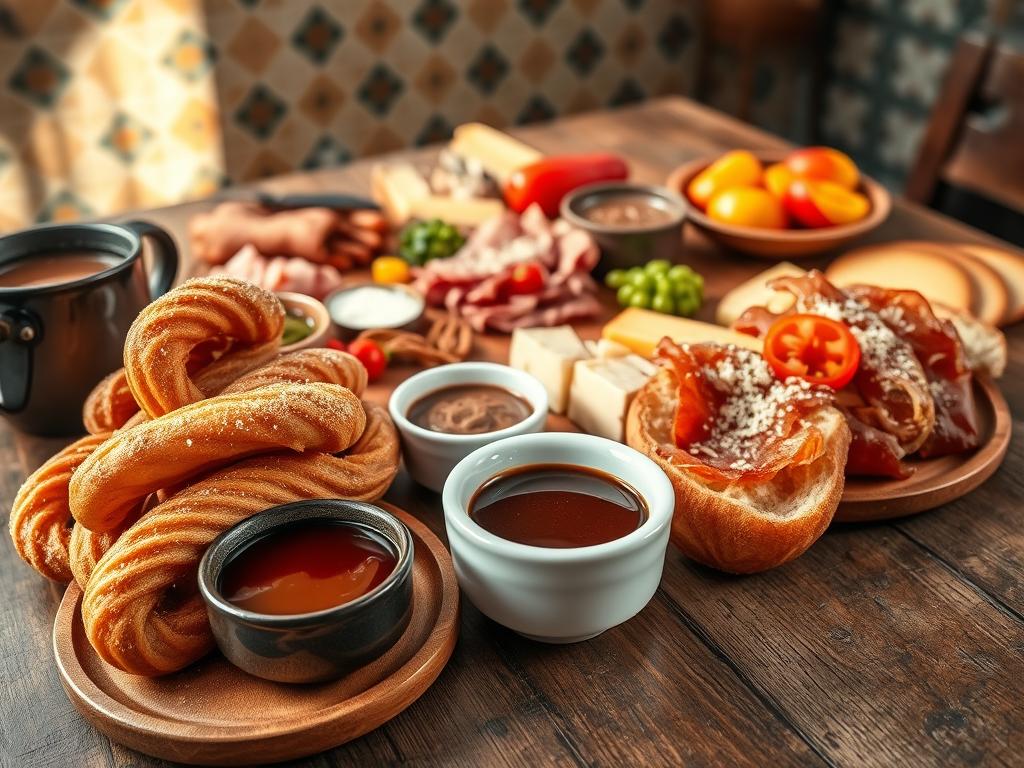Top Spanish Breakfast Foods to Try in 2025: From Churros to Mollete
Are you ready to start your day like a local in Spain? Finding the perfect morning meal can be tough. But once you know where to go and what to order, you’re in for a treat.
Spanish breakfast foods might seem hard to figure out at first. But with a bit of help, you’ll soon be enjoying churros con chocolate and other local favorites. You’ll find everything from sweet pastries to savory dishes, making your breakfast a delightful surprise.
Now, let’s explore the top dishes you should try on your next visit.
The Essence of Spanish Breakfast Culture
Exploring Spanish breakfasts reveals a wide range of dishes. These dishes show the country’s history and geography. Spanish breakfast culture is rich in tradition but has changed over time.
The Evolution of Spanish Breakfast Traditions
Spanish breakfasts, or ‘desayunos,’ have a long history. In the past, breakfast was simple, with bread, olive oil, and sometimes garlic or tomato. Today, breakfasts have grown, influenced by different regions and cultures.
Quality ingredients are key in Spanish cuisine, including breakfast. Traditional dishes focus on simple flavors. For example, Pan con Tomate is a favorite, made with garlic, tomato, and olive oil on toasted bread.
Regional Variations in Spanish Morning Meals
Spanish breakfasts vary greatly by region. Each area has its own breakfast traditions, based on local ingredients and cooking styles. In Andalusia, you might find Mollete, a bread roll with olive oil and toppings. Elsewhere, Churros con Chocolate is a favorite morning snack.
Exploring these regional differences shows the depth and variety of Spanish breakfasts. Whether you’re looking for Spanish breakfast menu ideas or just want to understand traditional Spanish breakfasts, there’s much to learn.
To make your own Spanish morning meals guide, try using local ingredients and traditional recipes. You might want to try different breads like Pan Gallego or Chusco. Or, experiment with toppings and spreads to find your favorite breakfast.
Popular Spanish Breakfast Foods You Need to Try in 2025
Exploring Spanish breakfasts in 2025 reveals a world of tasty dishes. These meals are full of flavor and are perfect for starting your day. They cater to all tastes, making mornings in Spain a joy.
Sweet vs. Savory Spanish Breakfast Options
Spanish breakfasts mix sweet and savory delights. For those who love sweets, churros con chocolate is a must-try. It’s a favorite around the world. You’ll also find pastries and sweet bread for a sweet treat.
For savory lovers, toast with tomato and olive oil is a favorite. Sandwiches, or “bocadillos,” filled with ham and cheese are also popular. Don’t miss out on tortilla de patatas, a thick potato omelet.
Breakfast Timing and Customs in Spain
In Spain, breakfast is from 7:00 to 10:00 AM, with 8:00 AM being the busiest time. People often go to cafes or bakeries for breakfast. There, they enjoy their meal with a coffee or tea.
Knowing when and where to eat breakfast in Spain adds to the experience. Whether it’s a quick snack or a long meal, following local customs makes it more authentic and fun.
For 2025, try a mollete, an Andalusian breakfast sandwich. Or, enjoy tostada con aceite y jamón, a simple yet tasty toast. Exploring these dishes shows that Spanish breakfasts are more than just food. They’re about the culture and tradition behind each dish.
Churros con Chocolate: Spain’s Beloved Morning Indulgence
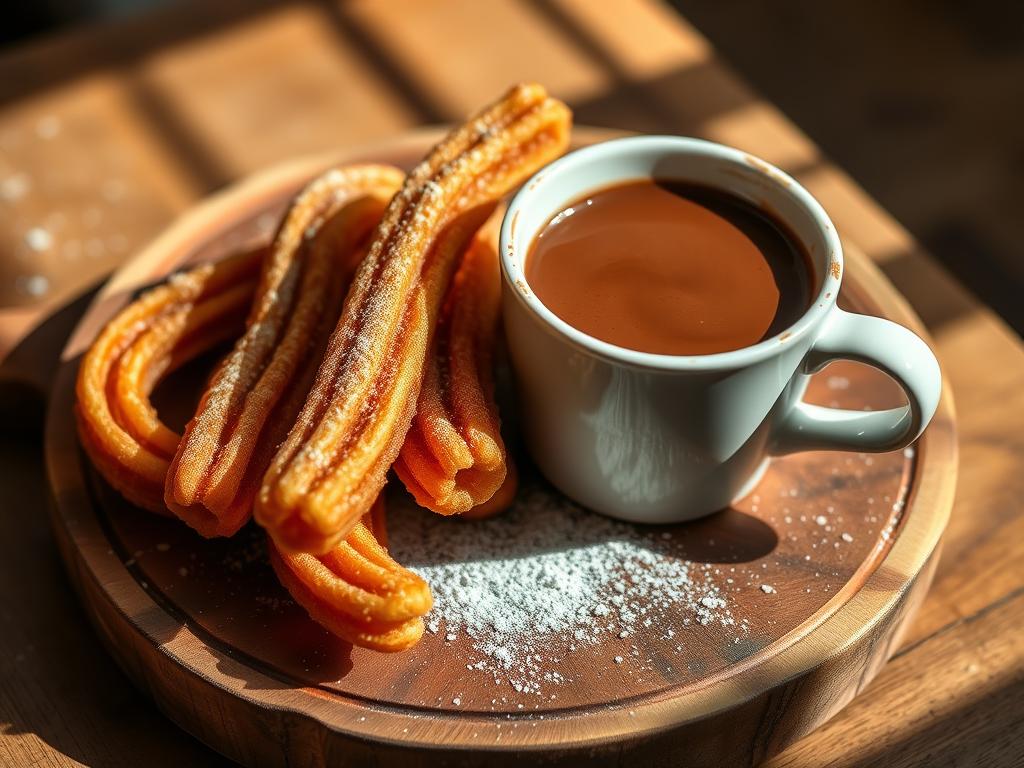
Churros con chocolate is a beloved Spanish breakfast treat. It’s a mix of fried dough and rich hot chocolate. This treat is more than just food; it’s a cultural tradition that brings people together.
The Perfect Churros Recipe for Home Preparation
To make churros con chocolate at home, start with the perfect churros. You’ll need flour, water, sugar, and vegetable oil. Here’s a simple recipe to get you started:
- 1 cup all-purpose flour
- 1/2 cup water
- 1/4 teaspoon salt
- 1/4 cup granulated sugar
- 2 large eggs
- Vegetable oil for frying
First, mix water, sugar, and salt in a saucepan and boil. Add flour and cook until it forms a ball. Let it cool, then mix in the eggs until smooth. Pipe the dough through a star tip into hot oil and fry until golden. Drain on paper towels and dust with sugar.
Pairing Your Churros with Authentic Spanish Hot Chocolate
The quality of the hot chocolate is key. Spanish hot chocolate uses dark chocolate for a deep flavor. It’s thick and luxurious. To make it, you’ll need:
- 1 cup dark chocolate chips
- 1 cup whole milk
- 2 tablespoons cornstarch
- 1 tablespoon sugar
Mix cornstarch with a little milk to form a slurry. Then, combine it with the remaining milk, chocolate, and sugar in a saucepan. Heat, whisking constantly, until the chocolate melts and the mixture thickens. Serve the hot chocolate in a deep cup alongside your freshly fried churros for an authentic Spanish breakfast experience.
By following these simple recipes, you can bring a taste of Spain into your home. Enjoy the delightful tradition of churros con chocolate for breakfast.
Pan con Tomate: The Simple Yet Exquisite Breakfast Staple
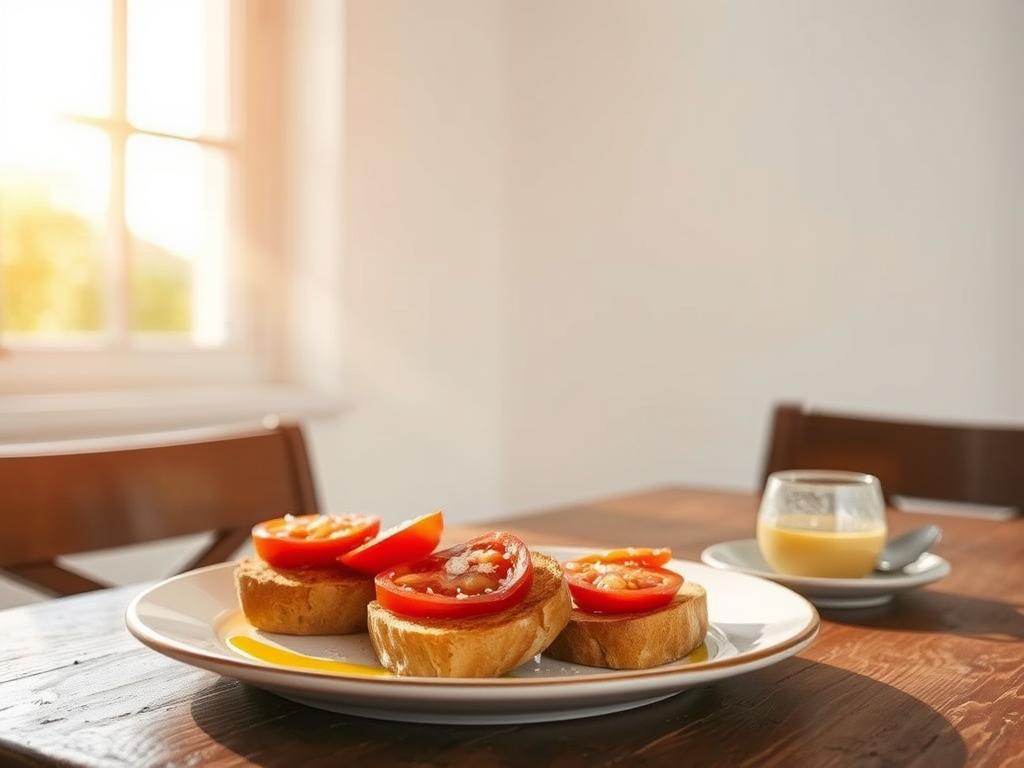
In Spain, the day starts with pan con tomate, a simple yet delicious breakfast. It’s more than food; it’s a way to connect with others. Pan con tomate, or “bread with tomato,” is a key part of Spanish breakfasts for many years.
Step-by-Step Guide to Making Perfect Pan con Tomate
Making pan con tomate is an art that needs just a few things: crusty bread, ripe tomatoes, olive oil, garlic, and salt. Here’s how to make it at home:
- Begin with a crusty bread, like a day-old baguette.
- Toast the bread until it’s lightly browned.
- Rub a clove of garlic over the toasted bread for extra taste.
- Grate a ripe tomato over the bread, making sure it’s evenly coated.
- Drizzle with high-quality extra virgin olive oil.
- Sprinkle a pinch of salt to taste.
Regional Variations and Toppings to Enhance Your Pan con Tomate
While the basic pan con tomate recipe is the same everywhere in Spain, different regions and personal touches can make it better. Some add paprika or cured ham for more flavor. You can also try different breads or add fresh herbs like parsley or basil.
Enjoying pan con tomate in a Spanish café or at home is a great way to start your day. Try it with a café con leche or fresh orange juice for a real Spanish breakfast.
Mollete: The Andalusian Breakfast Sandwich
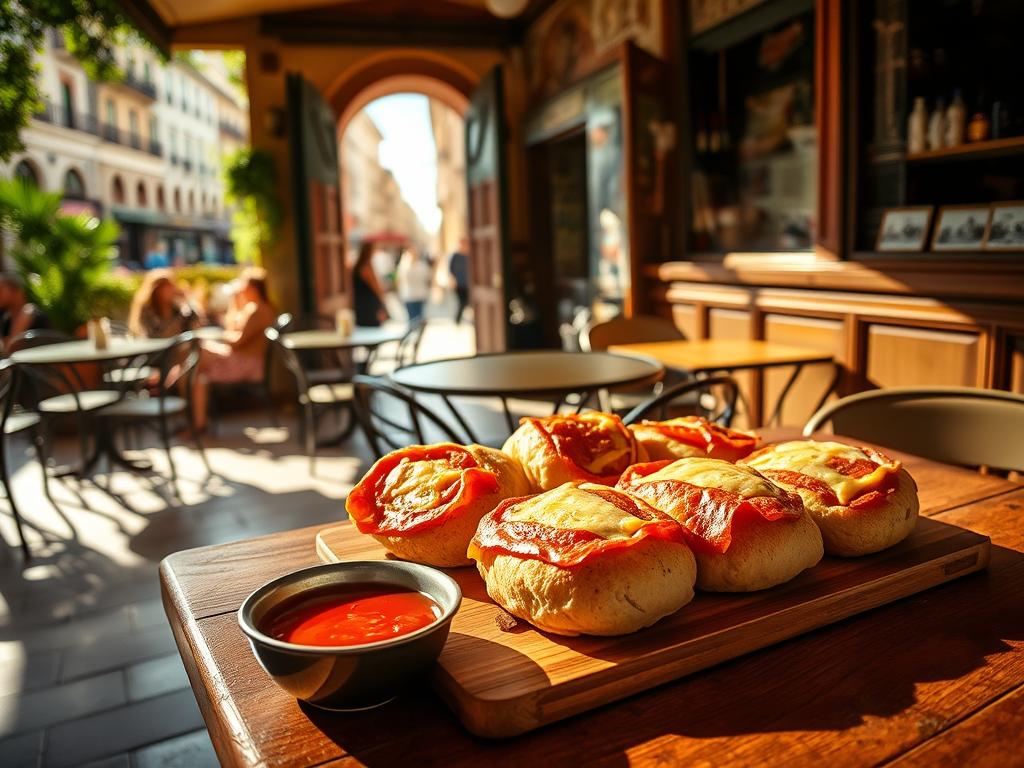
Andalusia is known for its rich food culture, and mollete is a big part of it. This simple yet tasty breakfast sandwich has been loved for centuries. It comes from Antequera and is made with soft, white bread that’s cooked just right.
Traditional Mollete Preparation Techniques
Making mollete is a skill that’s been passed down for generations. It starts with a special bread that’s soft but slightly crispy. To make it right, you need fresh bread every day. Then, it’s lightly toasted or grilled to get the perfect texture.
The toppings can change, but the classic one has olive oil, garlic, and salt. Some people like to add jamón ibérico or other local treats for extra taste.
Modern Twists on the Classic Mollete for 2025
As food trends change, so does the mollete. Chefs are now adding new flavors while keeping the recipe true to its roots. They might use different cheeses or add paprika for a bit of spice.
- Innovative toppings like truffle oil or avocado
- Using artisanal breads infused with herbs or spices
- Pairing mollete with contemporary beverages like craft coffee or fresh juices
These new takes on mollete attract both locals and tourists. They offer a fresh take on Andalusia’s traditional flavors.
Spanish Tortilla: A Hearty Breakfast Option
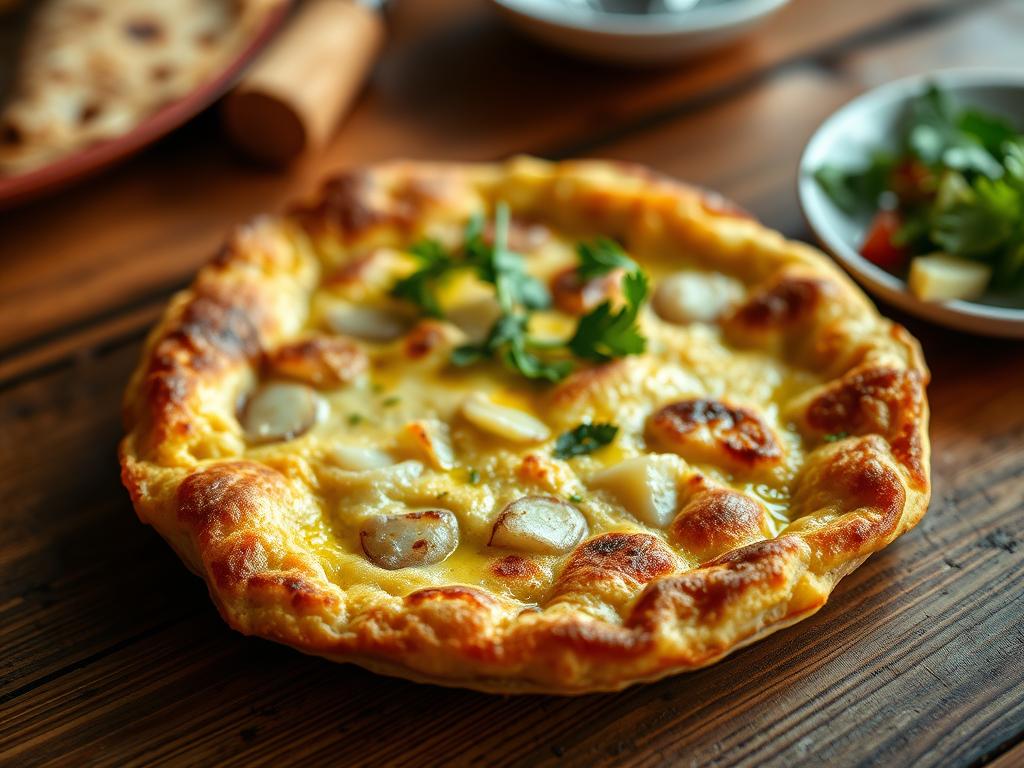
For a real Spanish breakfast, try a warm Spanish tortilla. It’s a thick omelette with potatoes, onions, and sometimes ham or chorizo. It’s a key dish in Spanish food and a great morning start.
Classic Spanish Tortilla Recipe and Techniques
To make a classic Spanish tortilla, you need potatoes, onions, eggs, olive oil, and salt. The secret to a great tortilla is in how you make it. Start by slicing the potatoes and onions thinly. Then, fry them in olive oil until they’re soft and lightly browned.
In a big bowl, beat the eggs with a pinch of salt. Add the cooked potatoes and onions to the eggs, stirring gently. Heat a non-stick pan with olive oil over medium heat. Pour in the egg mixture. Cook until it’s almost set, then flip and cook a bit more until it’s fully cooked and lightly browned.
Tips for the perfect tortilla:
- Use high-quality ingredients, like fresh eggs and good olive oil.
- Don’t overmix the egg mixture to keep the tortilla tender.
- Cook the tortilla over medium heat to prevent it from burning.
Serving Suggestions and Accompaniments for Tortilla
Spanish tortilla can be served in many ways. You can enjoy it alone or with different sides. For a simple breakfast, serve it with crusty bread or toast. Add fresh fruit or a salad for a lighter meal.
For a richer breakfast, try it with cured meats like jamón ibérico or chorizo. A sprinkle of fresh herbs like parsley or chives can also add flavor and color.
Try different ways to serve Spanish tortilla and find your favorite.
Tostada con Aceite y Jamón: Simplicity at Its Finest
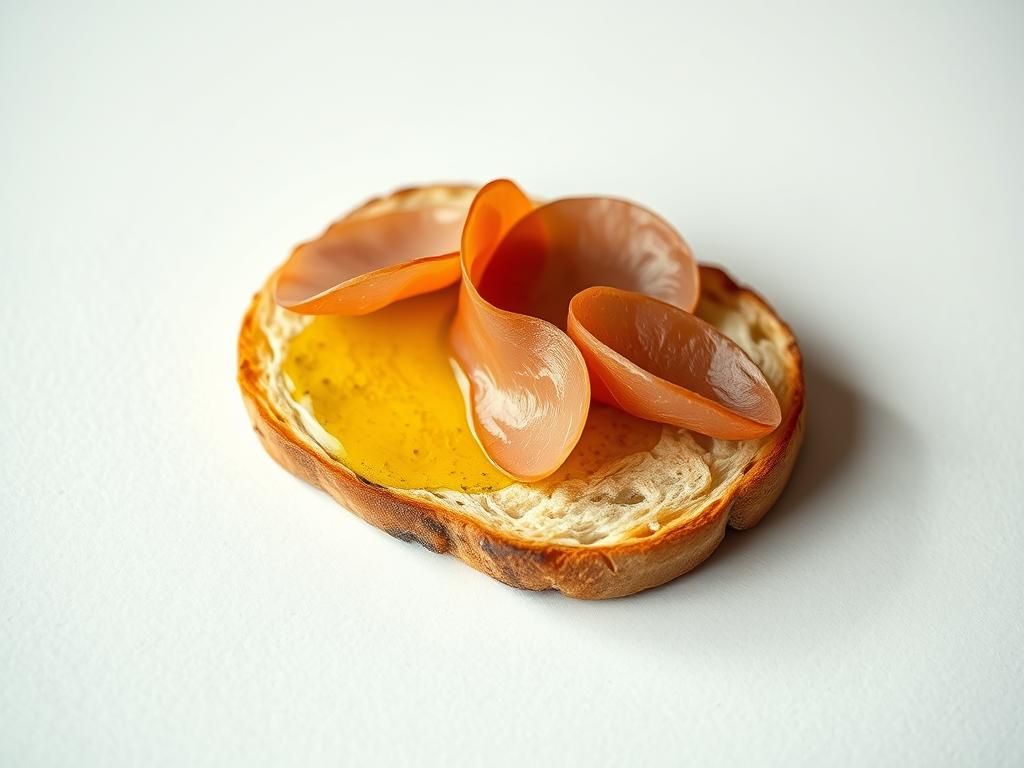
Tostada con aceite y jamón is a simple yet flavorful Spanish breakfast. It combines toasted bread, olive oil, and cured ham. This dish shows how Spanish cuisine values quality ingredients and simple preparation.
Selecting the Best Ingredients for Authentic Flavor
To make a real tostada con aceite y jamón, start with the best ingredients. You’ll need good bread, like a rustic or baguette-style loaf. Toast it until it’s golden and crispy.
The next key ingredient is extra virgin olive oil. Spanish olive oil is famous for its rich flavor and smooth texture. Pour it over the toasted bread for a unique taste.
The cured ham (jamón) adds a salty, savory touch. Choose a high-quality jamón ibérico or jamón serrano for that authentic Spanish taste.
Step-by-Step Preparation Guide
Making tostada con aceite y jamón is easy. Here’s how to make this tasty Spanish breakfast:
- Toast your chosen bread until it’s golden brown.
- Drizzle a generous amount of extra virgin olive oil over the toast.
- Top the toast with thin slices of cured ham.
- Serve immediately and enjoy!
This dish is not only simple to make but also highlights the quality of your ingredients. By following these steps, you can enjoy an authentic Spanish breakfast at home.
Pitufo Breakfast Sandwich: Málaga’s Morning Favorite

Start your day like a local in Málaga with the Pitufo. It’s a simple yet satisfying breakfast sandwich. Soft bread is filled with ham and cheese, making it a great way to begin your day.
What Sets Pitufo Apart
The Pitufo is special among Spanish breakfast foods. It combines flavors and textures in a unique way. The soft bread and savory ham and cheese create a perfect balance for your morning.
Key ingredients like high-quality ham and cheese are essential. The bread must be soft to complement the filling without overpowering it.
Popular Pitufo Variations to Try in 2025
While the traditional Pitufo is great, you can also try different versions. Some popular ones include:
- Adding fresh herbs like parsley or chives for extra flavor
- Using different cheeses, like Manchego or Mahon, for a unique taste
- Choosing artisanal ham for a richer savory flavor
These variations let you enjoy the Pitufo in new and exciting ways. It’s a versatile breakfast option for any setting, from casual cafes to upscale spots.
Porras: Churros’ Thicker Cousin
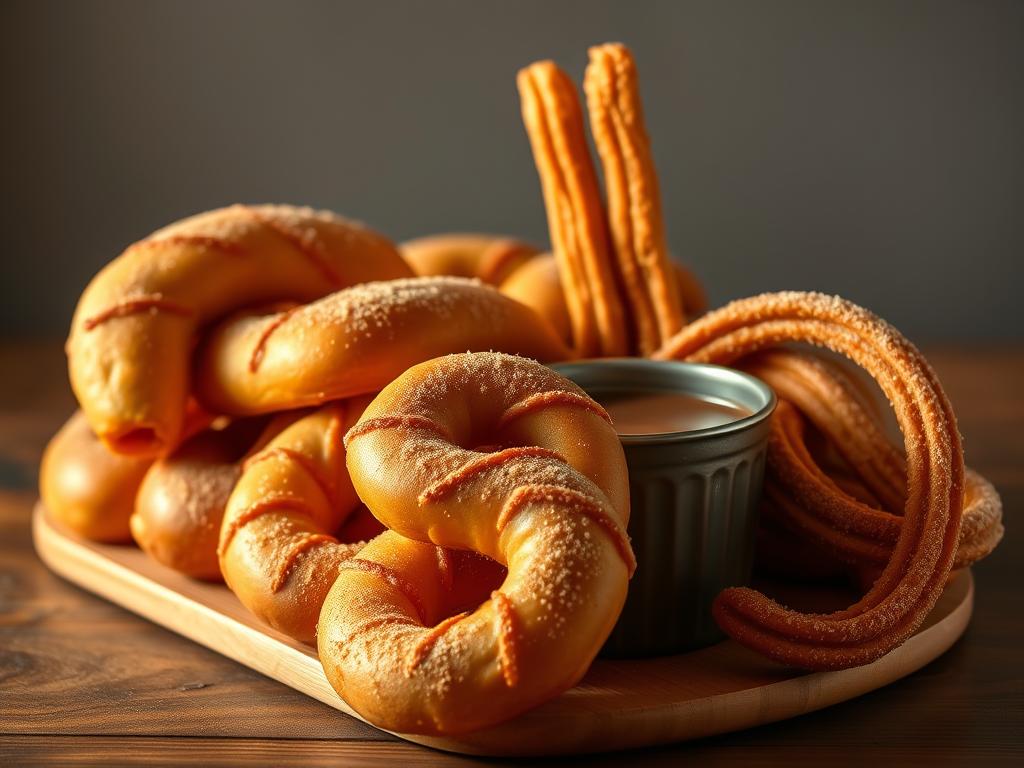
Exploring Spanish breakfast foods, you’ll find porras, a thicker cousin of churros. These fried dough pastries are similar to churros but have a unique texture. They add a special touch to Spanish breakfasts.
Differences Between Porras and Traditional Churros
Porras and churros differ mainly in thickness and texture. Porras are thicker and doughier, making them a more satisfying breakfast. This texture also changes how they’re enjoyed. While churros are often dipped in chocolate, porras can be topped with various items, making them versatile in Spanish breakfasts.
Here are some key differences:
- Thickness: Porras are thicker than traditional churros.
- Texture: The doughier texture of porras makes them more filling.
- Enjoyment: Porras are often enjoyed with various toppings or dips, not just chocolate.
Regional Preferences and Serving Styles
Regional tastes greatly influence how porras are enjoyed in Spain. In some areas, porras are a key breakfast item, often paired with churros con chocolate. This combo is a hit in the mornings, starting the day off right.
Some popular ways to enjoy porras include:
- Dipped in rich, thick Spanish hot chocolate.
- Served with a dusting of powdered sugar.
- Paired with a warm cup of coffee or café con leche.
As Spanish breakfast trends evolve, porras remain a favorite. They offer a delicious, authentic breakfast experience for everyone.
Café con Leche and Other Spanish Breakfast Beverages

Café con leche is a simple yet delightful mix of coffee and milk. It’s at the heart of Spanish breakfast culture. This beloved beverage is a staple in Spanish households, providing a comforting start to the day.
As you explore the world of Spanish breakfast, you’ll find café con leche enjoyed with various sweet and savory treats.
Perfecting Your Café con Leche at Home
To make authentic café con leche at home, you’ll need strong coffee and scalded milk. The key is to use equal parts of coffee and milk, creating a rich and creamy texture. You can use a stovetop or an espresso machine to brew your coffee, depending on your preference.
Tips for making great café con leche:
- Use high-quality coffee beans for the best flavor.
- Scald the milk to create a smooth, velvety texture.
- Adjust the ratio of coffee to milk to suit your taste.
Other Traditional Morning Drinks to Complement Your Spanish Breakfast
While café con leche is a favorite, other traditional Spanish breakfast beverages are worth trying. Chocolate a la Española, a thick and rich hot chocolate, is often enjoyed with churros or porras. For a lighter option, Zumo de naranja (orange juice) or Freshly squeezed grapefruit juice can provide a refreshing start to the day.
Some popular alternatives include:
- Café solo: a strong, black coffee for those who prefer it.
- Té con leche: tea with milk, a comforting and caffeinated alternative.
- Horxata: a sweet, milky drink made from tigernuts, popular in certain regions of Spain.
By incorporating these beverages into your Spanish breakfast routine, you can enhance your morning experience. You’ll explore the rich culinary traditions of Spain.
Healthy Spanish Breakfast Options for the Health-Conscious Traveler
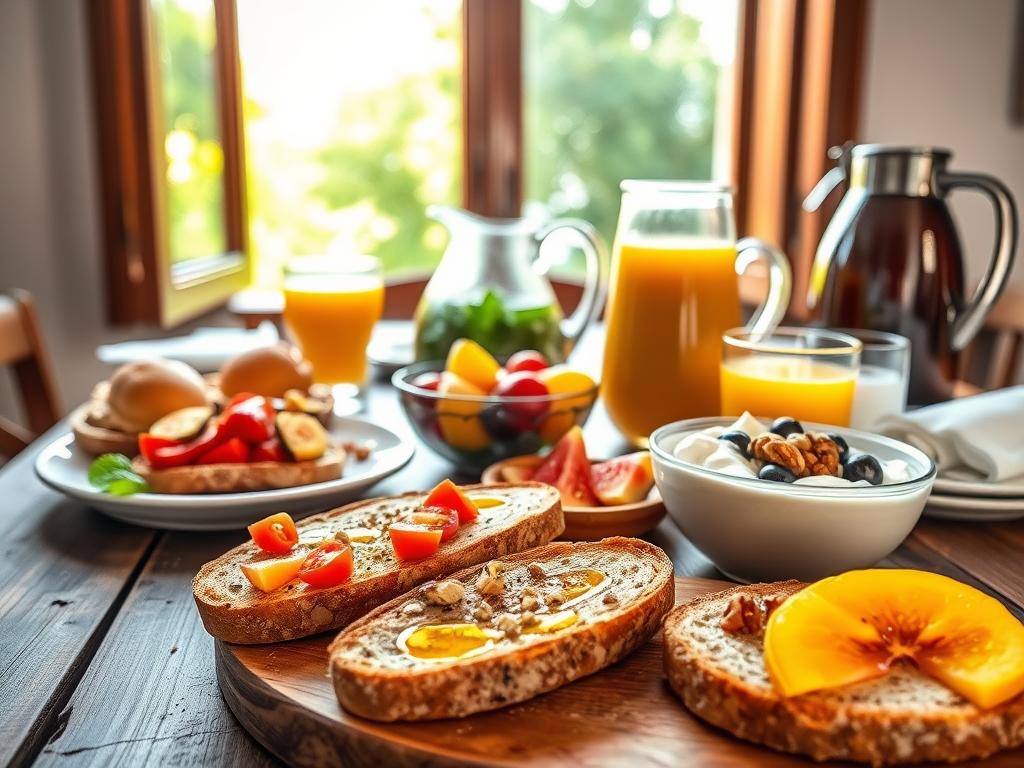
You don’t have to give up taste for health when trying Spanish breakfasts. There are many healthy choices for travelers. These options make starting your day delicious and nutritious.
Nutritious Spanish Breakfast Alternatives
Looking for healthier Spanish breakfast ideas? There are many good options. You can try:
- Whole grain toast with olive oil and tomato (Pan con Tomate)
- Fresh fruit or fruit salad
- Yogurt with honey and nuts
- Vegetable-based omelets
These choices are tasty and fit different diets. They make a great start to your day.
Adapting Traditional Recipes for Dietary Restrictions
Traditional Spanish breakfasts can be changed for different diets. For example:
- For gluten-free diets, use gluten-free bread in Mollete.
- Vegans can enjoy Churros made with plant-based milk and egg substitutes.
- Low-carb diets can focus on eggs or veggies for breakfast.
With a few tweaks, you can enjoy real Spanish breakfasts that fit your diet.
In summary, Spanish breakfasts are for everyone, no matter your diet. Choose healthy options and tweak traditional recipes. This way, you can have a fulfilling and healthy Spanish breakfast.
Conclusion: Embracing the Spanish Breakfast Experience in 2025
Exploring Spain’s rich culinary traditions in 2025 is a must. The diverse regional specialties and delicious dishes show the country’s vibrant morning culture.
From sweet churros con chocolate to simple pan con tomate, there’s something for everyone. Try making classic Spanish tortilla or hearty mollete at home. They’re great ways to start your day with a taste of Spain.
Typical Spanish breakfasts like tostada con aceite y jamón or porras offer a delicious, authentic experience. Whether you love food or just want to try something new, Spanish breakfasts are worth exploring. So, embark on a culinary journey through Spain’s regions and enjoy the flavors that make their breakfasts so loved.

